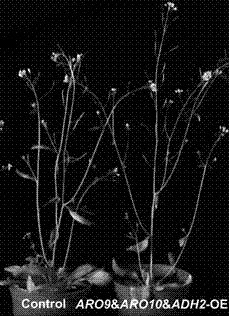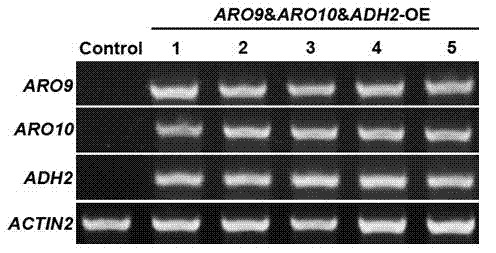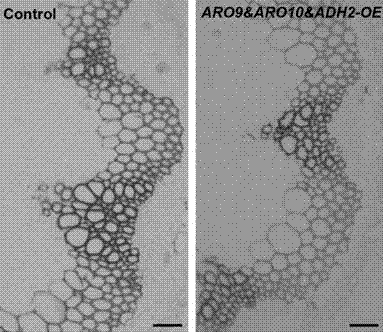Metabolic pathway reconstruction method for reducing lignin content and use thereof
A pathway, phenethyl alcohol technology, applied in the field of genetic engineering, can solve the problem of 2-phenylethyl alcohol synthesis and other problems, achieve great research value and application potential, and improve the effect of glucose efficiency
- Summary
- Abstract
- Description
- Claims
- Application Information
AI Technical Summary
Problems solved by technology
Method used
Image
Examples
Embodiment 1
[0025] The construction of the plant expression vector of embodiment 1 2-phenylethanol synthesis pathway:
[0026] 1. Yeast 2-phenylethanol synthesis pathway genes: ARO9 , ARO10 with ADH2 gene cloning
[0027] In order to construct the 2-phenylethanol synthesis pathway in plants, according to the report of the 2-phenylethanol synthesis pathway in Saccharomyces cerevisiae, select ARO9 (NM_001179267), ARO10 (NM_001180688) and ADH2 (NM_001182812) Construction of 2-phenylethanol synthesis pathway. Take Saccharomyces cerevisiae ( Saccharomyces cerevisiae ) extracted their genomic DNA, searched GenBank to obtain the full-length cDNA sequences of the two, respectively designed gene-specific primers, and used PCR technology to amplify the full-length cDNA of the three genes; finally, the two were connected into pMD19-T for sequencing. Amplification conditions were: 95°C for 5 min for pre-denaturation; 94 for 30 s, 55°C for 40 s, 72°C for 1 min, 35 cycles; 72°C for 8 min ...
Embodiment 2
[0036] Example 2 Application of constructing 2-phenylethanol synthesis pathway to reduce plant lignin content:
[0037] 1. Agrobacterium-mediated transformation of Arabidopsis
[0038] Will ARO9 with ARO10 The co-overexpressed plant expression vectors were transformed into Agrobacterium, and positive clones were picked and cultured overnight until OD=2.0. Centrifuge 300ml of overnight culture at room temperature to collect bacteria, and resuspend with 150ml transformation buffer (transformation buffer: containing 0.5% sucrose solution and 0.02% Silwet). Put the inflorescences of Arabidopsis thaliana upside down and immerse them in the bacterial solution. Try to immerse all the inflorescences in the bacterial solution for 5-6 times. Then put the Arabidopsis thaliana upside down in the water receiving tray, cover it with plastic wrap, and place it in the culture room. (22°C) overnight, and then cultured normally. After one week of transformation, it can be retransformed ag...
Embodiment 3
[0052] Example 3 Construction of 2-phenylethanol synthesis pathway to improve the efficiency of enzymatic hydrolysis and saccharification of plant cell walls
[0053] Efficiency analysis of cell wall extracts from Arabidopsis thaliana stems hydrolyzed by cellulase. The specific steps are:
[0054] (1) Divide the cell wall extracts into two treatment groups. The first group was directly treated with cellulose and β-glucosidase. Take 100 mg of the cell wall extracts from the control and transgenic plants, respectively, at 50 C. Treat for 24 hours under the condition of pH4.8, take 500 μl of the enzymatic hydrolyzate at 1, 3, 6, and 24 hours respectively, and measure the glucose content in the hydrolyzate.
[0055] (2) The second group took the cell wall extract and treated it with hot water (121°C) for 1 hour, then treated it with cellulase and glucosidase at 1, 3, 6, and 24 hours to measure the glucose content in the enzymatic hydrolysis product . Follow the instructions of...
PUM
 Login to View More
Login to View More Abstract
Description
Claims
Application Information
 Login to View More
Login to View More - R&D
- Intellectual Property
- Life Sciences
- Materials
- Tech Scout
- Unparalleled Data Quality
- Higher Quality Content
- 60% Fewer Hallucinations
Browse by: Latest US Patents, China's latest patents, Technical Efficacy Thesaurus, Application Domain, Technology Topic, Popular Technical Reports.
© 2025 PatSnap. All rights reserved.Legal|Privacy policy|Modern Slavery Act Transparency Statement|Sitemap|About US| Contact US: help@patsnap.com



